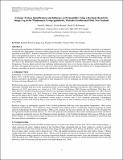| dc.contributor.author | Milicich, Sarah D. | |
| dc.contributor.author | Massiot, Cécile | |
| dc.contributor.author | McNamara, David D. | |
| dc.date.accessioned | 2018-10-02T13:57:16Z | |
| dc.date.available | 2018-10-02T13:57:16Z | |
| dc.date.issued | 2018-02-12 | |
| dc.identifier.citation | Milicich, Sarah D. , Massiot, Cécile , & McNamara, David D. (2018). Volcanic texture identification and influence on permeability using a borehole resistivity image log in the Whakamaru Group ignimbrite, Wairakei Geothermal Field, New Zealand. Paper presented at the 43rd Workshop on Geothermal Reservoir Engineering, Stanford, California, 12-14 February. | en_IE |
| dc.identifier.uri | http://hdl.handle.net/10379/14570 | |
| dc.description.abstract | Discerning the contributions to fluid flow in a geothermal reservoir from intrinsic and structural permeability components is an
important, yet difficult task. High-quality, resistivity borehole image log data (Formation MicroImager; FMI) collected from the
Whakamaru Group ignimbrite in well WK271, Wairakei Geothermal Field, New Zealand, has been used to investigate the textural
characteristics of volcanic rocks in the geothermal reservoir, with a view to improving reservoir model inputs. Textural analysis of the
FMI log in the Whakamaru Group ignimbrite was able to provide an improved internal stratigraphy compared to that derived solely
from drill-cuttings, and offers insights into the volcanic processes that generated it. Based on volcanic textures identified on the WK271
FMI image log, seven individual flow units in the Whakamaru Group ignimbrite are recognized, and are separated by texturally
characteristic intervals of airfall tephra. Comparison of fracture density and rock type (including welding intensity) shows a low fracture
density in non-welded ignimbrites and tuff beds. The logged interval occurs over a fault zone where permeability has previously been
inferred to be strongly influenced by fractures, precluding an accurate assessment of the ignimbrites intrinsic permeability. | en_IE |
| dc.description.sponsorship | This study is part of GNS Science’s New Zealand Geothermal Future research programme, funding of which was provided by the
Government of New Zealand. We thank Contact Energy Ltd. for the provision and permission to publish well data. The authors
acknowledge support of this work by Haliburton Software and Services, a Haliburton Company, through the use of RecallTM Borehole
software. Thanks to Fabian Sepulveda, Mark Lawrence, and Michael Rosenberg for valuable discussion and editorial comments. | en_IE |
| dc.format | application/pdf | en_IE |
| dc.language.iso | en | en_IE |
| dc.publisher | Workshop on Geothermal Reservoir Engineering | en_IE |
| dc.relation.ispartof | Stanford Geothermal Workshop | en |
| dc.rights | Attribution-NonCommercial-NoDerivs 3.0 Ireland | |
| dc.rights.uri | https://creativecommons.org/licenses/by-nc-nd/3.0/ie/ | |
| dc.subject | Borehole | en_IE |
| dc.subject | Resistivity Image Log | en_IE |
| dc.subject | Wairakei | en_IE |
| dc.subject | Permeability | en_IE |
| dc.subject | Volcanic Fabric | en_IE |
| dc.subject | New Zealand. | en_IE |
| dc.title | Volcanic texture identification and influence on permeability using a borehole resistivity image log in the Whakamaru Group Ignimbrite, Wairakei Geothermal Field, New Zealand | en_IE |
| dc.type | Conference Paper | en_IE |
| dc.date.updated | 2018-09-25T15:56:32Z | |
| dc.local.publishedsource | https://pangea.stanford.edu/ERE/db/IGAstandard/record_detail.php?id=28247 | en_IE |
| dc.description.peer-reviewed | peer-reviewed | |
| dc.internal.rssid | 14997232 | |
| dc.local.contact | David Mcnamara, -. - Email: david.d.mcnamara@nuigalway.ie | |
| dc.local.copyrightchecked | Yes | |
| dc.local.version | PUBLISHED | |
| nui.item.downloads | 454 | |


